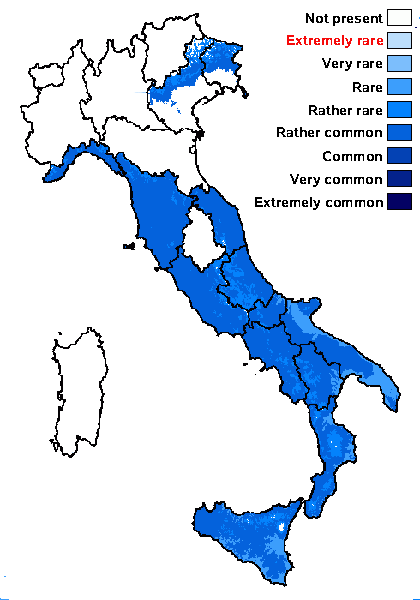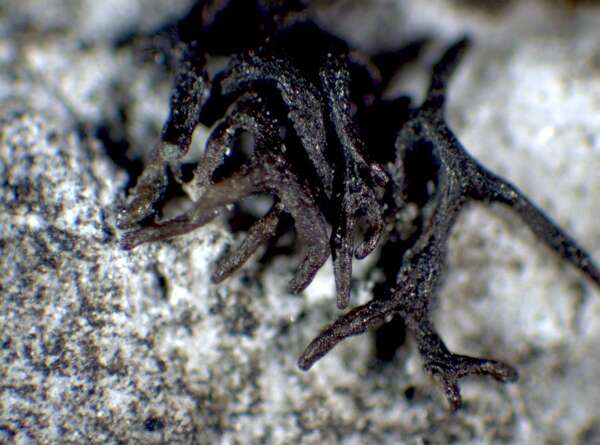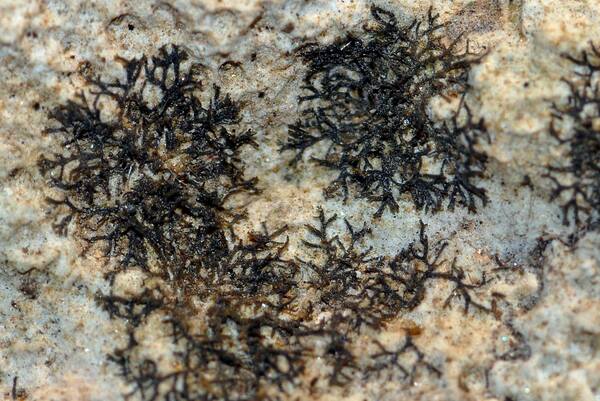Scytinium massiliense (Nyl.) Otálora, P.M. Jørg. & Wedin
Fungal Divers., 64, 1: 291, 2013. Basionym: Leptogium massiliense Nyl. - Flora, 62: 354, 1879.
Synonyms:
Distribution: N - VG, Frl (Tretiach & Carvalho 1995), Ven (Nascimbene & al. 2021), Lig (Jørgensen 1994). C - Tosc (Jørgensen 1994, Benesperi 2007, 2007b), Marc (Nimis & Tretiach 1999), Laz (Nimis & Tretiach 2004), Abr (Jørgensen 1994, Brackel 2015), Mol (Nimis & Tretiach 1999, Caporale & al. 2008). S - Camp (Aprile & al. 2003b, Nimis & Tretiach 2004, Garofalo & al. 2010), Pugl (Jørgensen 1994, Nimis & Tretiach 1999), Bas (Nimis & Tretiach 1999, Potenza 2006), Cal (Puntillo 1996), Si (Ottonello & al. 2006b).
Description: Thallus subfruticose, subgelatinous when wet, forming up to 1(-2) cm wide, 1-4 mm thick, rather loosely attached cushions, the lobes at first flattened, prostrate and irregularly spreading, up to 0.3 mm wide, then ascending and terete-filamentous, c. 3(-4) x 0.1-0.2 mm, dichotomously branched, brown to brown-black, somehow glossy, smooth or rarely longitudinally wrinkled, sometimes with isidia-like outgrowths. Upper and lower pseudocortex formed by regular layers of angular cells, the layer inbetween not paraplectenchymatous. Apothecia very rare, lecanorine, 0.3-0.4(-0.6) mm across, with a concave to flat, brown disc and a distinct thalline margin. Thalline exciple pseudocorticate; proper exciple pseudoparenchymatous; epithecium brownish; hymenium and hypothecium colourless; paraphyses coherent, mostly simple, the apical cells slightly swollen. Asci 8-spored, narrowly clavate, the apex strongly thickened, the apical dome K/I+ pale blue, with a downwardly projecting K/I+ deep blue tubular structure. Ascospores submuriform, with 3-5 transverse septa and 1-2 longitudinal septa, hyaline, ellipsoid, 15-27 x 7-11 μm, thin-walled. Pycnidia immersed. Conidia bacilliform. Photobiont cyanobacterial (Nostoc, the cells in short chains). Spot test: all negative. Chemistry: without lichen substances.Note: a mild-temperate to Mediterranean species found on steeply inclined surfaces of calcareous rocks with periodical seepage of water; certainly more widespread in Northern Italy.
Growth form: Fruticose filamentous
Substrata: rocks
Photobiont: cyanobacteria, filamentous (e.g. Nostoc, Scytonema)
Reproductive strategy: mainly sexual
On otherwise dry surfaces with short periods of water seepage after rain
Commonnes-rarity: (info)
Alpine belt: absent
Subalpine belt: absent
Oromediterranean belt: absent
Montane belt: rather rare
Submediterranean belt: rather common
Padanian area: absent
Humid submediterranean belt: rather common
Humid mediterranean belt: rather common
Dry mediterranean belt: rare

Predictive model
Herbarium samples
Growth form: Fruticose filamentous
Substrata: rocks
Photobiont: cyanobacteria, filamentous (e.g. Nostoc, Scytonema)
Reproductive strategy: mainly sexual
On otherwise dry surfaces with short periods of water seepage after rain
Commonnes-rarity: (info)
Alpine belt: absent
Subalpine belt: absent
Oromediterranean belt: absent
Montane belt: rather rare
Submediterranean belt: rather common
Padanian area: absent
Humid submediterranean belt: rather common
Humid mediterranean belt: rather common
Dry mediterranean belt: rare

Predictive model
| Herbarium samples |
 INDEX FUNGORUM
INDEX FUNGORUM
 GBIF
GBIF
 DOLICHENS
DOLICHENS





